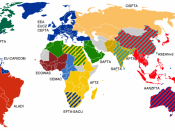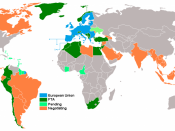International trade is becoming increasingly more prominent in Australia's economy as we are opening up to the global market. Australia is growing more efficient in the production of goods while also lowering import protection, giving our exports a more competitive drive in the world. Foreign trade with other countries can be strengthened with the use of "free trade".
Free Trade removes the barrier of protection that disturbs the flow of goods and services between countries. .
Some of these restrictions include:
* Tariffs - Taxes on imported goods.
* Quotas - Restrictions on the quantity of goods
* Subsidies - Payments to local producers for fairer competition
* Tax Concessions - Given to firms competing against imports.
* Local Content Rules - Imported goods must have a certain quantity of locally made components.
Australia has four Free Trade Agreements
* The Australia-United States Free Trade Agreement (AUSFTA) has been in place since January 2005
* The Thailand-Australia Free Trade Agreement (TAFTA) has been in place since January 2005
* The Singapore-Australia Free Trade Agreement (SAFTA) has been in place since July 2003
* The Australia-New Zealand Closer Economic Relations Trade Agreement (ANZCERTA) has been in place since 1983.
Australia's largest trading partners are United States, Japan China and the U.K. The Australian Government has a diverse and ambitious trade policy with its main goal - striving to create new and more open markets for exports. This is shown:
* Multilaterally through the World Trade Organization
* Regionally through APEC and the Closer Economic Partnership with ASEAN
* Bilaterally through free trade agreements, such as those with Singapore, Thailand and the United States and, through efforts to expand markets and address market barriers in a range of countries.
Many trade agreements are becoming more politically aware as well as economically. As...


